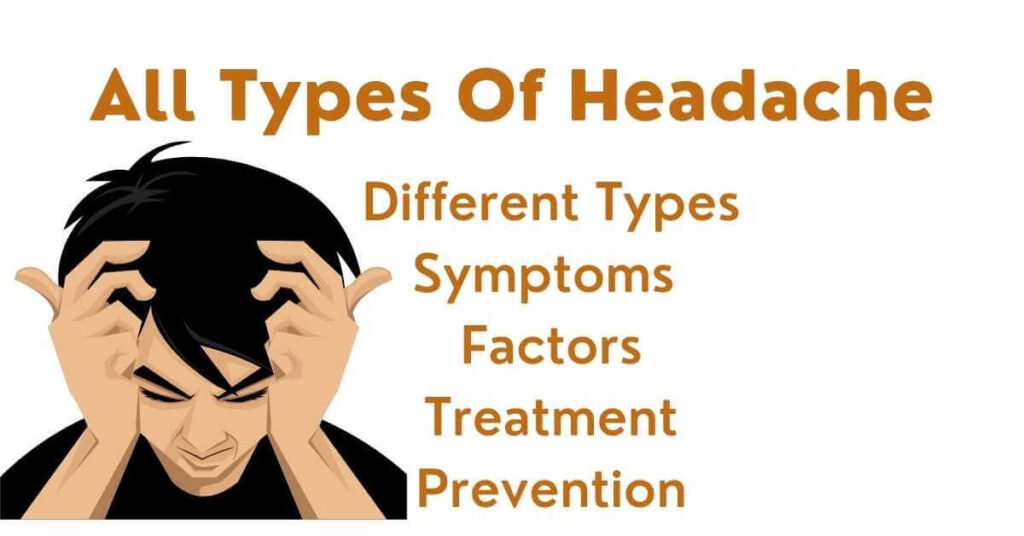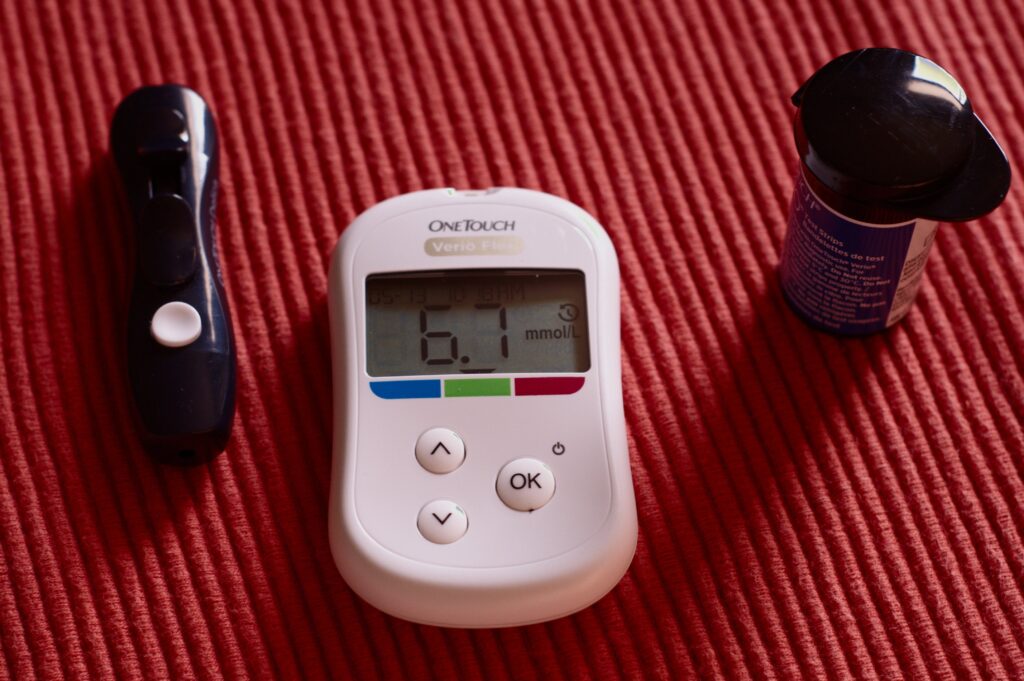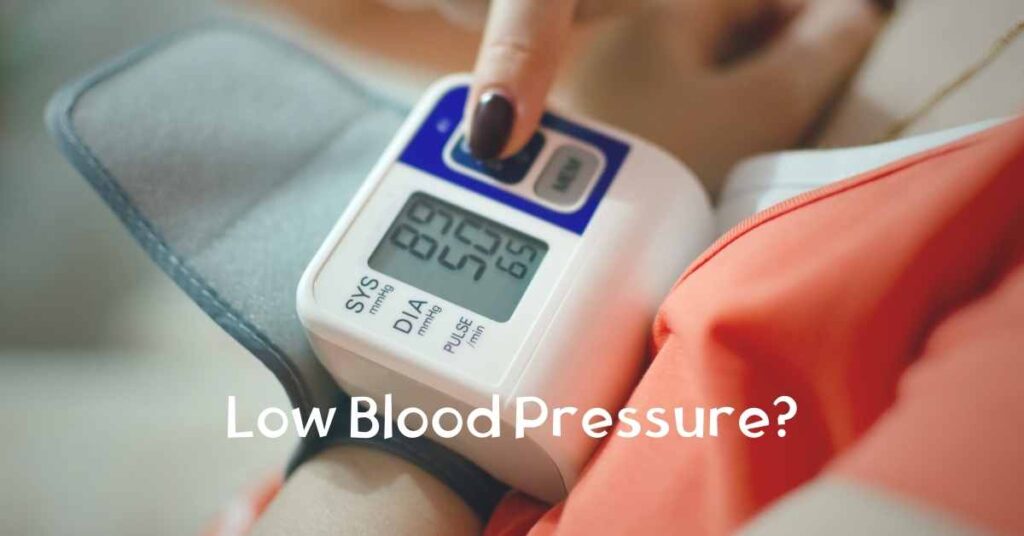We discussed all the possible different types of Headache in a complete headache chart. If you are facing headache, look at this chart, so that you can find which type of the headache you have!
Allergy Headache-
Symptoms
- Generalized headache
- Watery eyes
- Nasal congestion
Triggering Factors
Seasonal allergens like molds, pollen, etc. Usually, food allergy is not a factor.
Treatment
Antihistamine medication, topical or nasal cortisone related sprays, desensitization injections.
Prevention
For allergy headache no prevention is there other than you can avoid the causing factors of allergy.
Aneurysm-
Symptoms
It may mimic cluster headache or frequent migraine. The bulge in the blood vessel wall or balloon-like weakness of the blood vessel wall causes it. Rupture of the blood vessel may occur( such as in stroke), or slowly leaking of blood may result in a sudden unbearable headache with double vision and rigid neck. The person becomes unconscious rapidly.
Triggering Factors
Congenital tendency and extreme hypertension.
Treatment
When an aneurysm is detected early, then treatment is done with surgery.
Prevention
Regulation of blood pressure is very important. So keeping the blood pressure under control is recommended.
Caffeine Withdrawal Headache-
Symptoms
Rebound dilation of the blood vessels cause throbbing headache. It typically occurs several days after the consumption of large quantities of caffeine.
Triggering Factors
Caffeine. More specifically sudden withdrawal of caffeine.
Treatment
No particular treatment. In extreme cases, gradually withdrawal of caffeine consumption is advised.
Prevention
Try to low down caffeine consumption gradually.
Cervicogenic Headache-
Symptoms
Pain on one side of the head or face (unilateral), pain around the eyes, neck, shoulder, or arms, stiff neck, blurred vision, sensitivity to light and sound, nausea.
Triggering Factors
Arthritis of the upper spine, neck injury, malformations of the cervical vertebrae.
Treatment
Treatment differs based on the severity of symptoms. Usually non-steroidal anti-inflammatory drugs (aspirin or ibuprofen), physical therapy, nerve block, transcutaneous electrical nerve stimulation( TENS), neuromodulation surgery.
Prevention
Treatment is mandatory because, without treatment, it can be debilitating.
Chronic Daily Headache-
Symptoms
It is a broad range of headache disorders. It usually occurs more than 15 days a month. Based on the headache duration, it has two categories- less than 4 hours and more than 4 hours.
Triggering Factors
It typically evolves from transformed migraine. Although not related to chronic tension type headache, but they may evolve from episodic tension type headache. It can also be associated with the overuse of medication.
Treatment
Depending on the type and severity, different treatment options are available. It is essential to limit the use of analgesics.
Prevention
Prevention depends upon the number of attacks per month, duration of headache, and the cause of headache.
Chronic Migraine-
Symptoms
In this type, a headache occurs more than 15 days a month, for more than three months and has the features of migraine headache on at least eight days per month.
Triggering Factors
It is associated with rebound headache or overuse of medication. It can also be associated with major life events, obesity, ineffective acute medications.
Treatment
Headaches will either revert to episodic or may remain chronic after withdrawal of the drug. Botox and CGRP monoclonal antibodies have been approved for use in cases of chronic migraine.
Cluster Headache-
Symptoms
Excruciating pain in the vicinity of the eye, tearing of the eye, congestion of nose, flushing of the face. Pain may develop during sleep and may last for several hours. Attacks occur every day for weeks or months and then disappear for up to a year. Eighty percent of patients are male, commonly between the ages of 20 and 50.
Triggering Factors
Excessive smoking, intake of alcohol
Treatment
- Oxygen
- Medication- Sumatriptan, Ergotamine, or Intranasal application of the local anesthetic agent.
Prevention
Use of steroids, ergotamine, calcium channel blockers, and lithium.
Depression and Headache-
Symptoms
People with any underlying disease, especially painful diseases, tend to become depressed. This depression causes headache. Actually headache appears as preliminary symptom of any kind of depression.
Triggering Factors
Physical, emotional, and psychic factors widely can cause it.
Treatment
General medicines help to treat the headache. But as the main cause is depression so, treatment of depression is a must. Else, this headache repeatedly appears.
Many times only therapeutic treatments like counselling is sufficient to remove the depression. Else, medication is needed.
Prevention
Headache associated with depression can be treated by selective serotonin reuptake inhibitor, monoamine oxidase inhibitor, a tricyclic antidepressant.
Eyestrain Headache-
Symptoms
Bilateral pain (pain on both sides), usually frontal, is directly associated with Eyestrain. It is not a common type of headache.
Triggering Factors
Uncorrected vision, imbalance of muscles, astigmatism.
Treatment
Vision correction.
Prevention
Vision correction.
Exertional Headache-
Symptoms
Generalized head pain with short duration ( minutes to an hour ) occurs during or following any type of physical exertion such as jumping, running, sexual intercourse, etc. It can even be due to passive exertion such as sneezing, coughing, etc.
Triggering Factors
90 percent cases are due to migraine or cluster headache. Ten percent of cases are due to aneurysm, tumor, or blood vessel malformation.
Treatment
Diagnosis of the cause is very important. Usually, indomethacin or propranolol is given to treat it. Extensive testing is needed to figure out the actual cause. Surgery is sometimes necessary to correct aneurysms, tumors, etc.
Prevention
It is best to avoid exercise. One can use alternative forms of exercise.
Fasting Headache-
Symptoms
Non pulsating, diffuse pain with mild to moderate intensity in frontal location.
Triggering Factors
It is caused by fasting.
Treatment
Headache should go away within 72 hours after eating.
Prevention
Try to eat small meals multiple times daily.
Fever Headache-
Symptoms
Generalized head pain that occurs with a fever. It is usually caused by swelling of the blood vessels of the head.
Triggering Factors
It is caused by infection for which the fever occurs.
Treatment
Antibiotics, Acetaminophen, Aspirin, NSAID is usually given to treat the fever
Prevention
None.
Giant Cell Arteritis-
Symptoms
A burning, dull, or jabbing pain. It is usually caused by inflammation of the temporal arteries. During chewing, pain may occur around the ear. Eyesight problems may occur. It usually occurs in people over 50 years of age.
Triggering Factors
May be due to vascular disease. Inflammation of blood vessels can precipitate the condition.
Treatment
Erythrocyte sedimentation rate (ESR) and C- reactive protein test can be done. A biopsy of the temporal artery confirms the condition. After diagnosis, treatment is done with oral corticosteroids.
Prevention
None.
Hangover Headache-
Symptoms
Throbbing pain and nausea-like migraine, it is not localized to one side.
Triggering Factors
Alcohol is a precipitating factor because it causes dilation and irritation of blood vessels in the brain and surrounding tissue.
Treatment
Consumption of fructose like honey, tomato juice, etc., Liquids including broth can help.
Prevention
If you have hangover problem, avoid drinking alcohol. If you can not avoid to drink alcohol, always drink in a moderate amount.
Headache Due to Infection-
Symptoms
Presence of acute infection and fever. Pain is diffuse, moderate to severe in intensity.
Triggering Factors
Some Infection in your body is the only triggering factor.
Treatment
Antibiotics,acetaminophen,aspirin, NSAID are given to treat the headache due to infection.
Prevention
None.
Hemiplegic Headache-
Symptoms
Severe throbbing pain, sometimes in one side of the head, numbness, weakness or paralysis on one side of the body, dizziness, speech difficulty, visual disturbance, loss of balance, nausea, vomiting, sensitivity to light, sound, and smell. In this type of headache, symptoms are similar to a stroke.
Triggering Factors
Genetic component plays an important role.
Treatment
When the diagnosis is confirmed, treatment is dietary modification, avoiding known triggers, regular exercise, good sleep, and dietary supplementation such as magnesium. Topiramate, valproic acid, and calcium channel blockers are given. Triptans must be avoided because they may cause severe complications.
Prevention
Good sleep, regular exercise, dietary modification, avoiding known triggers, and preventive medications help.
Hunger Headache-
Symptoms
Pain occurs just before mealtime. Missing a meal, low blood sugar, oversleeping, muscle tension, and rebound dilation of the blood vessels can cause this type of headache.
Triggering Factors
Skipping a meal and strenuous dieting.
Treatment
Taking nourishing meals regularly that contains adequate protein and complex carbohydrates.
Prevention
Not skipping the meals.Regular intake of nourishing meals.
Hypertension Headache-
Symptoms
The pain is severe in the morning and diminishes throughout the day. Pain is generalized and “hairband” type.
Triggering Factors
More than 200 systolic and 110 diastolic pressure. So severe hypertension causes it.
Treatment
Treatment-Control blood pressure with appropriate blood pressure medication and lifestyle modification.
Prevention
Keeping blood pressure under control.
Menstrual Headache-
Symptoms
Migraine type pain occurs shortly before, during, or immediately after menstruation. Pain may also occur at the mid-cycle, that is, at the time of ovulation.
Triggering Factors
Variation of estrogen level.
Treatment
When the onset of symptoms starts, treat with ergotamine, dihydroergotamine, or a 5-HT agonist. When the pain begins, treatment is similar to migraine without aura.
Prevention
Biofeedback,beta blockers (propranolol,Timolol), anticonvulsant (divalproex sodium), calcium channel blockers, NSAIDs.
Migraine with Aura-
Symptoms
First visual disturbance occurs. Numbness in the arm or leg may also occur. These are warning symptoms. These warning symptoms subside within 30 minutes, then severe pain occurs.
Triggering Factors
Heredity plays some role. Menopausal hormone, pills, excessive hunger, certain foods, weather, changes in altitude, light, excessive smoking, emotional stress, etc., are other precipitating factors.
Treatment
When the symptoms first appear, treat with a biofeedback mechanism, ergotamine, dihydroergotamine, or a 5-HT agonist. When the pain starts, treat with ice packs, mucate, isometheptene, a combined product containing caffeine, ergotamine, DHE injectable, nasal spray,5-HT agonist, analgesic, the medication that constrict the blood vessel. For attacks that are prolonged, steroids may give some relief.
Prevention
Biofeedback, beta-blockers (propranolol,timolol), anticonvulsant (divalproex sodium), calcium channel blocker, NSAID. CGRP monoclonal antibodies have recently been approved for prevention.
Migraine without Aura-
Symptoms
Symptoms-One sided severe, throbbing pain, sometimes associated with nausea, vomiting, sensitivity to sound and light, cold hands.
Triggering Factors
Heredity plays some role.Menopausal hormones,pills,excessive hunger,certain foods,weather,changes in altitude,lights,excessive smoking,emotional stress etc.
Treatment
Ice packs, isometheptene, mucate, combination products containing caffeine, ergotamine, DHE injectable and nasal spray, 5-HT agonists, analgesics, the medication that constrict blood vessels. For attacks that are prolonged, steroids may give some relief. CGRP monoclonal antibodies have recently been approved for prevention.
Prevention
Biofeedback, beta blockers (propranolol, timolol), anticonvulsant (divalproex sodium), calcium channel blockers, NSAIDs.
New daily persistent Headache-
Symptoms
Symptoms-Rapid development ( less than three days ) of unrelenting headache. It typically occurs in those who do not have a history of headache.
Triggering Factors
It typically begins as a new headache, maybe a result of viral infection. It does not originate from migraine or episodic tension type headache.
Treatment
It can go away on its own within several months. Other cases may persist and are more refractory. Prevention-It does not respond to traditional treatment options. Instead, one can use Antiseizure medication, Topamax, or Neurontin.
For more details you can check out our complete guide on New Daily Persistent Headache.
Post Traumatic Headache-
Symptoms
Pain may mimic migraine or tension type headache symptoms. Generalized or localized pain usually occurs daily. Sometimes resistant to treatment.
Triggering Factors
Sometimes, it is difficult to determine the cause of this headache; minor trauma can trigger pain in this type of headache.
Treatment
Anti Inflammatory drug, propranolol, or biofeedback.
Prevention
Prevention-Standard precautions against trauma
Sinus Headache-
Symptoms
Gnawing pain over the nasal area sometimes pains severity increases throughout the day. Acute infection with fever, blockage of sinus ducts prevent normal drainage. Sinus headaches are uncommon.
Sometimes migraine and cluster headache are misdiagnosed as sinus in origin.
Triggering Factors
Infection, nasal polyp, anatomical deformities like deviated septum that causes blockage of sinus ducts.
Treatment
Antibiotics, decongestants, surgical drainage when needed.
Prevention
None.
TMJ (Temperomandibular Joint) Headache-
Symptoms
Muscle contraction type pain, On the opening of jaw painful clicking sound, may occur. Not so common type of headache.
Triggering Factors
Malocclusion (poor bite), jaw clenching, stress.
Treatment
Relaxation, biofeedback mechanism, use of bite plate are primarily used as treatment. Sometimes correction of bite is necessary.
Prevention
Same as treatment.
Tension-Type Headache-
Symptoms
Dull, non throbbing pain, sometimes occur in both sides, tightness of scalp or neck. The degree of severity remains constant.
Triggering Factors
Hidden depression, emotional stress, etc.
Treatment
Rest, aspirin, acetaminophen, ibuprofen, naproxen sodium, a combination of analgesic with caffeine, muscle relaxant, ice packs, antidepressant, biofeedback, psychotherapy, temporary use of more potent prescription analgesic if needed.
Prevention
Avoid stress, use biofeedback, relaxation technique, antidepressant medication.
Tic Douloureux headache ( Trigeminal Neuralgia)-
Symptoms
Short, jab-like pain in the face around mouth or jaw. These are the trigger areas of pain. The frequency and duration of the pain vary. It is more common in women over 55 years of age,
Triggering Factors
Exact cause is not known. Pain from cold air, chewing, touching the face, etc., can result from Multiple sclerosis if occurs before age 55.
Treatment
Anticonvulsant, muscle relaxant, neurosurgery.
Prevention
None
Thunderclap Headache-
Symptoms
Sudden severe pain, sometimes associated with nausea, vomiting, fever, seizure speech problem, weakness, confusion, visual disturbance.
Triggering Factors
May be due to benign syndrome or a potentially life threatening condition.
Treatment
Since the nature of the headache can not tell whether it is due to benign cause or serious cause, it is very important to seek emergency medical help.
Prevention
None.
Tumor Headache-
Symptoms
Pain becomes worse with time, projectile vomiting, visual disturbance, speech change, personality change, a problem with equilibrium, gait or coordination, seizure. It is an extremely rare type of headache.
Triggering Factors
Cause of the tumor is usually not known.
Treatment
When discovered early, treat with surgery or a newer radiological method.
Prevention
None.





